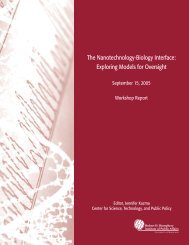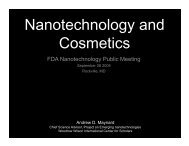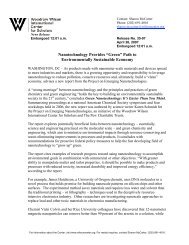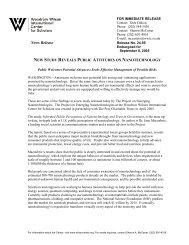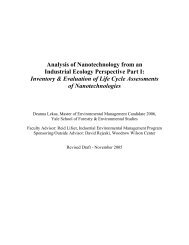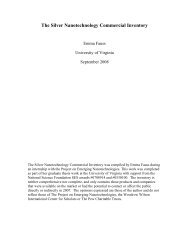nanotechnology oversight - Project on Emerging Nanotechnologies
nanotechnology oversight - Project on Emerging Nanotechnologies
nanotechnology oversight - Project on Emerging Nanotechnologies
Create successful ePaper yourself
Turn your PDF publications into a flip-book with our unique Google optimized e-Paper software.
Nanotechnology Oversight:<br />
An Agenda for the New Administrati<strong>on</strong><br />
11<br />
EPA is by far the largest of the four agencies.<br />
Its budget is larger than that of FDA,<br />
OSHA and CPSC combined. EPA also has<br />
the broadest mandate of any of the four agencies,<br />
but even more relevant is that EPA, unlike<br />
the other regulatory agencies, has major functi<strong>on</strong>s<br />
in additi<strong>on</strong> to its regulatory activities.<br />
EPA has a large science comp<strong>on</strong>ent that does<br />
both applied and basic research. It provides<br />
funding and technical assistance for c<strong>on</strong>structi<strong>on</strong><br />
of waste-treatment facilities and for the<br />
operati<strong>on</strong> of state polluti<strong>on</strong> c<strong>on</strong>trol agencies. It<br />
has 10 regi<strong>on</strong>al offices. Although EPA’s resp<strong>on</strong>sibilities<br />
have expanded, its budget, as illustrated<br />
in Table 1, has shrunk. In c<strong>on</strong>stant dollars,<br />
EPA’s budget is significantly less than it was in<br />
the early 1970s, before it was given such major<br />
resp<strong>on</strong>sibilities as TSCA, the Superfund program<br />
and implementati<strong>on</strong> of the 1990 Clean<br />
Air Act amendments.<br />
FDA’s budget, unlike the budgets of the<br />
other three agencies, has increased in recent<br />
decades. However, most of that increase is<br />
attributable to user fees, which are dedicated to<br />
pre-market reviews of drugs and other products.<br />
As Michael Taylor, a former FDA official<br />
and now a professor at George Washingt<strong>on</strong><br />
University, has observed, “FDA lacks the<br />
resources it needs to build its own <str<strong>on</strong>g>nanotechnology</str<strong>on</strong>g><br />
expertise, to develop the safety testing protocols<br />
and detecti<strong>on</strong> methods needed to evaluate<br />
new <str<strong>on</strong>g>nanotechnology</str<strong>on</strong>g> products, to c<strong>on</strong>duct<br />
its own risk research, to gather the necessary<br />
pre-market data required to get ahead of commercializati<strong>on</strong><br />
and to oversee products after<br />
they have entered the market” (Taylor 2006, p.<br />
7). Taylor notes that for FDA to be able to do<br />
what it was doing in 1996 and to c<strong>on</strong>tinue the<br />
new activities mandated for it since then, the<br />
agency’s 2007 budget would have to be more<br />
than 50 percent greater than it is (ibid.).<br />
OSHA’s problems are largely due to politics.<br />
Protecting workplace safety is essential,<br />
but OSHA has been largely beholden to <strong>on</strong>e<br />
c<strong>on</strong>stituency—labor uni<strong>on</strong>s—a c<strong>on</strong>stituency<br />
tied to <strong>on</strong>e of the country’s two major political<br />
parties, the Democrats. In recent decades,<br />
neither the uni<strong>on</strong>s nor the Democrats have<br />
fared particularly well, and neither has<br />
OSHA. If OSHA is to take <strong>on</strong> the task of protecting<br />
workers from excess exposure to nanomaterials,<br />
it will need more resources, regardless<br />
of which party wins in 2008.<br />
CPSC does not have the m<strong>on</strong>ey, expertise<br />
or regulatory tools to deal with <str<strong>on</strong>g>nanotechnology</str<strong>on</strong>g>.<br />
At present, its main functi<strong>on</strong> is to serve as<br />
an excuse for not regulating c<strong>on</strong>sumer products.<br />
Legislati<strong>on</strong> now moving through<br />
C<strong>on</strong>gress would help CPSC and may include<br />
funding earmarked to deal with <str<strong>on</strong>g>nanotechnology</str<strong>on</strong>g>.<br />
But the legislati<strong>on</strong> is <strong>on</strong>ly a band-aid <strong>on</strong> a<br />
gaping wound. The new administrati<strong>on</strong> and<br />
C<strong>on</strong>gress will have to decide whether they are<br />
serious about the safety of c<strong>on</strong>sumer products.<br />
If they are, they must enact legislati<strong>on</strong> that<br />
gives the agency greater authority to prevent<br />
the marketing of dangerous products rather<br />
than to recall them after they are in people’s<br />
homes. The commissi<strong>on</strong> form of agency rule<br />
is a prescripti<strong>on</strong> for cumbersome decisi<strong>on</strong><br />
making and muddled resp<strong>on</strong>sibility. CPSC<br />
will also require greatly increased resources.<br />
It is bey<strong>on</strong>d the scope of this paper to suggest<br />
what the budgets of the regulatory agencies<br />
should be. It is important to point out,<br />
however, that the actual dollars c<strong>on</strong>sumed by<br />
the agencies are a very small part of the federal<br />
budget. The combined total FY 2009 proposed<br />
budgets for the four agencies are about<br />
10 percent of the budget of the Department of<br />
Agriculture. The total of the budgets of all<br />
four agencies equals 3 percent of the cost over-



